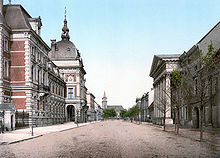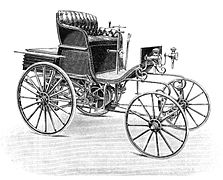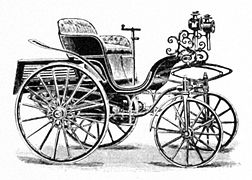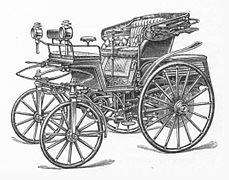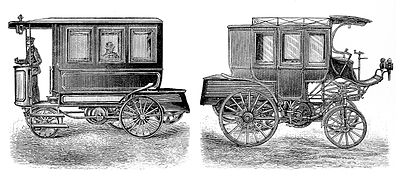Friedrich Lutzmann
Friedrich Leopold Christoph Lutzmann (born April 5, 1859 in Nienburg (Saale) , † April 23, 1930 in Dessau ) was a German inventor , designer and entrepreneur . Along with Carl Benz and Gottlieb Daimler, he was one of four exhibitors at the First International Motor Show (IAA) in 1897 with two of his motor vehicles. In 1899, the Opel brothers bought their Dessau motor vehicle factory and thus entered the automotive industry. They made Lutzmann director of the Opel vehicle works and produced their first automobile with the Opel patented motor car "System Lutzmann" . The cooperation with Lutzmann lasted two years.
biography
First steps and training
Friedrich Lutzmann was born in 1859 in the city of Nienburg an der Saale as the son of Christian Carl Lutzmann, who was employed as a ducal tax overseer and district treasurer, and his wife Karoline Frederike (née Krause). He was the eldest son of the family and had two brothers and a sister with his siblings Richard, Albert and Anna. His school education began with attending the community school in his hometown of Nienburg, between the ages of 10 and 16 he attended high schools in Dessau and Köthen . This was followed by an apprenticeship as a locksmith and plumber for three years and an apprenticeship as a tool smith for one year. The training was followed by a wandering in which he worked in art and construction machine fitters in Leipzig , Apolda and Koblenz , as well as the time in the military.
After his military service, Lutzmann worked for the Dessau-Cottbuser-Maschinenbau-Actien-Gesellschaft in Cottbus and then for the administration of the Dessau gas works, where he was responsible for laying the gas pipelines and installing gas appliances and steam boilers . This was followed by a job in Richard Baumbach's machine factory in Dessau and then another wandering through various art locksmiths, especially in Dresden in Herrmann Darme's art locksmith's shop. Inspired by the exhibits in the Dresden arts and crafts exhibition, he went to Vienna to work in the then famous workshop of the royal-imperial court art locksmith.
As an art locksmith in Dessau
In January 1884, Friedrich Lutzmann continued his journey to work in Italy . His wanderings took him from Trieste via Venice , Ferrara , Bologna , Florence , Rome , Naples and Genoa to Milan . He then worked for a year with the art locksmith Johann Meyer in Lucerne , Switzerland, and then for half a year in an art locksmith's workshop in Berlin . Following this, he opened his own workshop in Dessau as a building and art locksmith's shop. Within three years, the workshop developed so far that Lutzmann was able to buy the house in which he had been renting until then. One of his first works was the art-forged iron grating that still exists today around the mansion of the Commerce Councilor Albert Meinert , today's "Toad Courtyard" in Wasserstadt 40.
His work became known and especially Albert Meinert's father, who ran a cloth factory, became an important major customer. Lutzmann married Alwina Hulda Pohle from Raguhn on September 24, 1887 . In order to make his work more effective, he developed a technique in which he could work faster with the help of mechanical forging sinks . The most important order for Lutzmann was to produce a large decorative grille with double-leaf entrance gates for the palace of the Hereditary Prince von Anhalt xx von Auer. For his good work he was awarded the title of “master locksmith” on May 21st, but the palace and with it the gate were demolished in 1927 and can no longer be visited today.
In addition to his work as an art locksmith, Lutzmann also worked on the repair and maintenance of the duke's carriages. On August 18, 1890, he was granted a patent for an adjustable shear beam holder, which made it easier to harness the horses to the carriage. Lutzmann also had a bicycle workshop where he also sold Rover bicycles .
Anti-Semitism and Political Activities
Friedrich Lutzmann played a leading role in the Dessau local group of the anti-Semitic German Confederation for raising the middle class (later: the German Reform Association ) , which was founded on April 8, 1891 . The members of the association, which was closely related to the German Social Party , came mainly from the local middle class ; Lutzmann's business partner Fritz Koch was among them. The German Reform Association organized in Dessau among other ethnic -nationalistische and anti-Semitic speeches like that of Paul Ranger on July 8, 1892, entitled "German patriotism and his opponents."
The first taxi company in Germany
The first motor car was developed by Carl Benz in 1886 and Friedrich Lutzmann also began to be interested in it a short time later. Accordingly, he turned to automobile manufacture in 1893, after seeing the first motor car in Dessau on April 28 of that year. It was the vehicle of the industrialist Fritz Kühne, a four-seater Benz Victoria Vis-à-Vis , with which he came from Leipzig to Dessau. Lutz man and his friend, the plumber champion Fritz Koch , heard about it in the newspaper and surveyed the vehicle. They talked to Kühne, who out of enthusiasm for motor vehicles had also taken over the representation of Benz vehicles in addition to his central heating company. In his own words, Lutzmann decided that evening to build motor vehicles himself.
Via Kühne, he ordered his own Benz Victoria Vis-á-Vis from Benz & Cie. in Mannheim , which he received after a four-month waiting period and was able to pick it up there. On the return trip, she was accompanied by a fitter who only did not take the last leg from Leipzig to Dessau and returned to Mannheim.
On September 17th, Fritz Koch and Lutzmann jointly opened the "Motorwagen-Fahr-Verkehr" , which traveled the routes from Dessau to Wörlitz and to Aken . In the optimal case, the journey time was about an hour, in which the 15 kilometers were covered, and the three passengers had to pay one mark per person as the fare. This was the first opportunity for passengers to try a motor vehicle, but in winter the demand for transport in open vehicles fell noticeably. On January 19, 1894, the company started again, this time with a leather hood specially made for the vehicle. Operations were maintained until the railway line opened on September 22nd, 1894, after which Lutzmann and Koch became the first taxi operators in Germany, taking over driving services in Dessau. In 1894 the tram was introduced in Dessau , which was much cheaper, so that they needed a new field of activity again.
The automotive design and production
Probably in May 1894 (the exact date is not known), a good year after Lutzmann's first encounter with the Benz motor car, the company's first roadworthy vehicle left the factory hall.
Lutzmann only employed around 20 workers in his Dessau factory, significantly fewer than, say, its competitors Daimler (DMG) and Benz.
Model versions
Overall, the Lutzmann motor vehicle was offered in at least 14 different versions, most of which were nicknamed the "arrow". At least one of each of these model variants was actually built.
From left to right: arrow A, arrow 1, arrow 2 with half-top, arrow 5 and arrow 4
The first international automobile exhibition
On September 30, 1897, the Central European Motor Vehicle Association was founded in the Hotel Bristol in Berlin , Germany's first automobile club . Friedrich Lutzmann was one of the founding members, as well as representatives from Daimler, Benz, Škoda , Siemens & Halske and Kühlstein .
Following the founding meeting, an automobile exhibition was held, followed by a demonstration drive to Grunewald . This exhibition was the first of its kind in Germany and the predecessor of the International Motor Show .
There were only four exhibitors: Benz with three, Daimler with one and Lutzmann with two motor vehicles. as well as cooling stone with an electric car. The automobiles exhibited by Lutzmann were arrow 0 and arrow 1 .
The Opel period

At the end of the 19th century, the bicycle market was flooded, which led to significant sales losses for Opel . There was also a general economic slump. The Opel brothers therefore started looking for another mainstay. At the automobile exhibition of 1897, Wilhelm and Fritz Opel then contacted Friedrich Lutzmann. They also visited the Lutzmanns motor vehicle factory in Dessau twice.
Finally, Sophie Opel , who ran the Opel works after the death of her husband , decided, at the instigation of her sons, to buy Lutzmann's entire factory, all the machines and patents, and to move them to Rüsselsheim. There was also a largely completed Arrow 0 patent motor car . Lutzmann was to become director of the new motor vehicle production facility in Rüsselsheim, and all workers from Dessau were to be taken over.
According to the contract, the purchase price was a total of 116,687 marks (today's equivalent: approx. € 800,000). The annual salary for Lutzmann should be a generous 8,000 marks (approx. 55,000 €). The contract was finally signed on January 21, 1899. Since then, this date has been considered the official start of automobile manufacturing at Opel. From February the first motor vehicles were produced in a corner of the Rüsselsheim Opel works.
On June 8, 1899, Hulda Lutzmann died at the age of 37 in Rüsselsheim after a long illness. She left him three children: Friedrich, Charlotte and Katharina. Lutzmann then threw himself into his work. Lutzmann married a second time on May 31, 1900. Anna Marie Ochsenhirt, divorced Vombach, became an enthusiastic car driver and on July 29, 1900 became the first Opel works racing driver. She also brought two children of her own from her first marriage into the family. Their daughter Else was born on July 14, 1901.
The Opel patent motor car
The Opel patented motor car "System Lutzmann" was a light automobile, based on the Lutzmann Pfeil 0 , which did not have the axle fork steering usual for the larger Lutzmann models, but a stub axle steering . The wrought iron ornaments were also dropped in favor of a simpler body design. The first advertisements, however, still showed old Lutzmann "Pfeil" models, some of which were no longer produced.
The engine with a single horizontal cylinder got 3.5 HP from about 1.5 liters, which was good for a top speed of over 20 km / h. The speeds were slightly on the Lutzmann motor car to 650 min -1 raised. The engines of the Opel motor vehicle were now made of significantly cheaper gray cast iron. However, this change was not that easy and required the purchase of a special cylinder drilling machine.
In the first motor vehicle brochure from the second half of 1899, Opel also advertised a truck, a further development of the Lutzmann Pfeil 6 , as well as a four-seater called “Duc” based on the “Break” model . The truck was christened "Colossus von Rüsselsheim" by the contemporary press.
As can be seen from an order book still in existence, special requests from customers were always met to a large extent, in addition to more powerful motors, for example, modern carbide lamps .
In 1899 only 11 vehicles were delivered. By 1900 the number of employees had increased to over 70. About 65 copies were made until 1901 before Opel stopped production.
A fully functional example (four-seater) is now owned by Adam Opel AG, another (two-seater) is in the Deutsches Museum in Munich.
Opel's departure from Lutzmann
By 1900 Lutzmann's design was already out of date, especially when compared to modern automobiles from France (for example from Renault or De Dion-Bouton ), which often already had a front-mounted motor and axle drive via a cardan shaft . The body also had to be clearly distinguished from a horse-drawn carriage.
Lutzmann also had to accept that, and so the Opel brothers were forced to part with him.
In 1901 the Opel brothers initially took over the general agency for Renault in Germany, and in 1902 a cooperation agreement was signed with the French automobile manufacturer Alexandre Darracq , which lasted until 1907. However, the two years of automobile production with the Lutzmann patented motor vehicle brought valuable experience.
The late years
After Lutzmann had left Adam Opel AG, he tried a new start by buying a mineral water beverage factory in Untermhaus near Gera , which also included 12 branches with drinking houses in the area. The contract signed with Opel did not allow him to continue working in the automotive industry. However, the company was sluggish and remained a grant business for the second year. At the end of 1903 he had to file for bankruptcy.
In October 1903, the entire Lutzmann family embarked on the Hamburg-America Line to Porto Alegre . Among other things, Lutzmann wanted to look around for new opportunities in South America, but was unsuccessful. The family returned to Europe in autumn 1904 and settled in Zurich , where Lutzmann worked in the typewriter industry.
After the First World War , Lutzmann lost the assets he had left in Germany due to inflation. In September 1922 he finally returned to Dessau. Hugo Junkers , with whom Lutzmann had been friends since the time of the “Anhaltische Motorwagenfabrik”, now offered him a job as archive manager. On May 30, 1925, Junkers even invited him and his wife to a sightseeing flight on the occasion of their silver wedding anniversary. In the following year, however, Junkers had to part with Lutzmann due to economic difficulties.
The now 68-year-old then turned to the city of Dessau with a request for support. He was then given an apartment for himself and his wife in the retirement home on Herzogsallee (today Mendelssohn-Strasse) 14.
Lutzmann died on April 23, 1930 and was buried in Dessau Cemetery III. An important chapter in the early days of automobile construction ended with his death. Only a few years later did the city of Dessau erect a simple memorial stone for him.
aftermath
The widow Marie Lutzmann received a late honor when she was granted an honorary pension by the Reich Association of the Automobile Industry in 1936 by order of the Reich government . This enabled her to live an old age without financial worries.
There has been a Lutzmannstrasse in Dessau since 1996. Adam Opel AG's corporate headquarters in Rüsselsheim am Main has been located on Friedrich-Lutzmann-Ring since 1998.
The city of Nienburg an der Saale , Lutzmann's birthplace, is planning a memorial column for which donations are currently being collected.
literature
- Manfred Riedel: Friedrich Lutzmann - A pioneer of automobile construction . Anhaltische Verlagsgesellschaft mbH, Dessau 1999, ISBN 3-910192-61-0 .
- Hans-Jürgen Schneider: 125 years of Opel. Cars and technology. Schneider + Repschläger, Cologne 1987.
Web links
- lutzmann.de
- Opel press release
- Opel Patent Motor Car (Video, 1.9 MB)
- Portrait of John Adolphus & Kathleen Koosen (English)
- Lutzmann motor tricycle (picture)
Individual evidence
- ↑ Bernd G. Ulbrich : Anti-Semitism in Dessau. A search for traces in the years 1924 to 1939. Edition RK, Dessau 2004, ISBN 978-3934388208 , p. 10 f.
- ↑ "The matter has been shamefully little researched" on projektgegenpart.org
- ^ Calendar sheet Dessau April 8th
- ^ Association for the Promotion of Cultural Projects in Nienburg Saale e. V.
| personal data | |
|---|---|
| SURNAME | Lutzmann, Friedrich |
| ALTERNATIVE NAMES | Lutzmann, Friedrich Leopold Christoph |
| BRIEF DESCRIPTION | Car pioneer, designer and entrepreneur |
| DATE OF BIRTH | April 5, 1859 |
| PLACE OF BIRTH | Nienburg (Saale) |
| DATE OF DEATH | April 23, 1930 |
| Place of death | Dessau |


